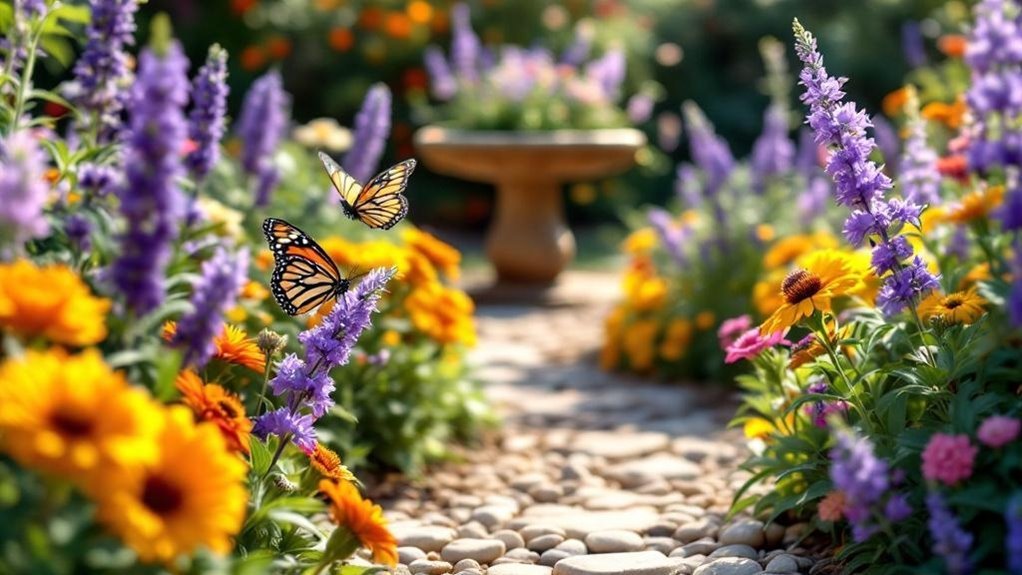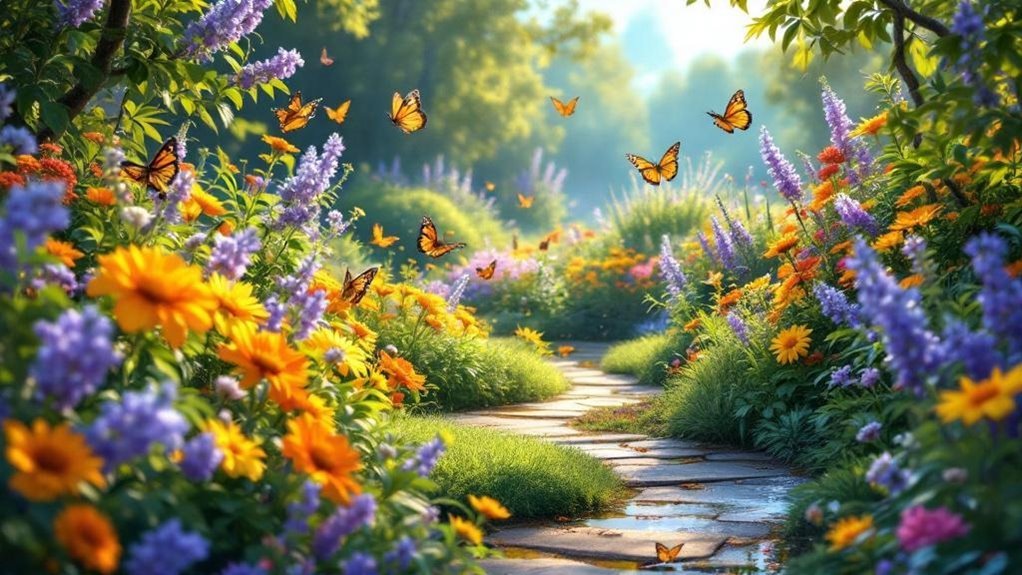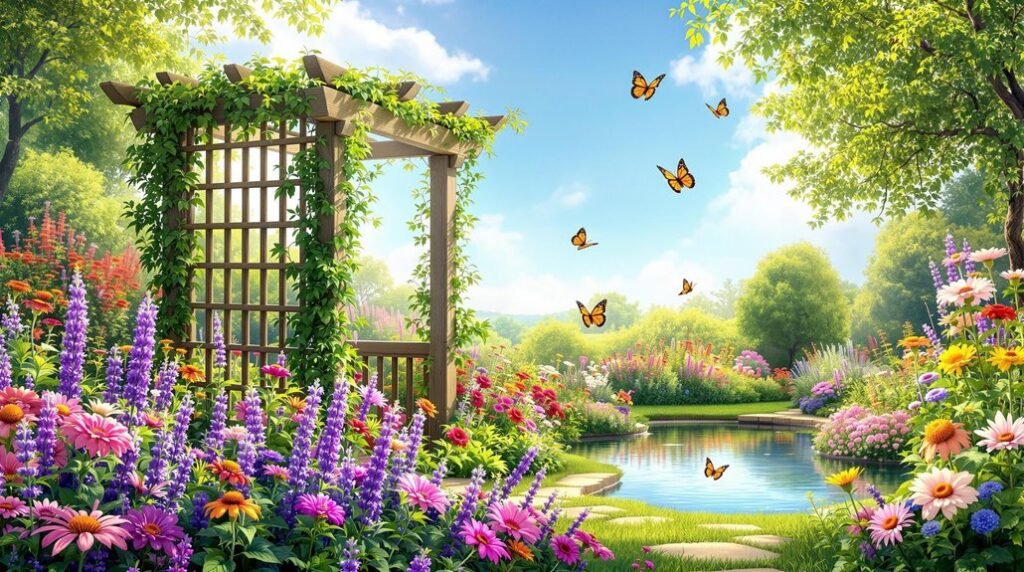Imagine a community park that transformed a neglected corner into a thriving butterfly garden, doubling its visitors in just one season. You can create a similar space by carefully selecting plants and designing features that butterflies love. But attracting these delicate creatures isn’t just about flowers—it involves thoughtful planning and ongoing care. Let’s explore how you can build a garden that not only supports butterflies but also becomes a favorite spot for your visitors.
Selecting the Best Location for Your Butterfly Garden
When selecting the best location for your butterfly garden, choose a sunny spot that gets at least six hours of direct sunlight daily, as butterflies need warmth and light to stay active. A sunny location attracts adult butterflies and helps native plants thrive.
Place your garden near accessible water sources like shallow dishes or bird baths to keep butterflies hydrated. Provide shelter from wind by adding tall plants or structures, creating a calm environment for local butterfly visitors.
Incorporate diverse plant heights to offer visual interest and reduce travel distance between nectar plants. Positioning your garden close to woods or meadows will increase butterfly visits by connecting to natural habitats.
Choosing Nectar and Host Plants
Choosing the right nectar and host plants is essential to attracting and supporting butterflies in your garden. You’ll want to plant a variety of nectar-rich flowering plants like purple coneflower and butterfly bush that bloom throughout the season. Also, include specific host plants that serve as caterpillar food for local butterfly species, such as milkweed for monarchs and parsley for swallowtails. Group these plants in clusters to create a successful butterfly-friendly environment, making it easier for butterflies to find food and lay eggs.
| Plant Type | Example Plant | Purpose |
|---|---|---|
| Nectar Plant | Purple Coneflower | Attract butterflies |
| Nectar Plant | Butterfly Bush | Continuous nectar source |
| Host Plant | Milkweed | Monarch caterpillar food |
| Host Plant | Parsley | Swallowtail caterpillar |
| Flowering Plant | Azalea | Bright color attraction |
Providing Essential Garden Features

To create a welcoming butterfly garden, you’ll want to provide essential features that support their needs beyond just plants. Start by including a reliable water source, like a shallow bird bath or a pebble-filled dish, so butterflies can hydrate easily.
Group nectar-rich plants with bright blooms together to attract butterflies efficiently, minimizing their travel time. Incorporate varied plant heights, combining shrubs and perennials, to offer shelter and resting spots that keep butterflies safe and comfortable.
Don’t forget to place flat stones in sunny areas; these warm spots help butterflies regulate their body temperature. Finally, use trees or shrubs to create sheltered zones, protecting your visitors from wind and harsh weather.
These features will help you create a butterfly garden that truly invites and supports these beautiful pollinators.
Managing Pesticides and Protecting Pollinators
After setting up your garden with features that attract and support butterflies, you need to protect these visitors from harmful chemicals.
Avoid broad-spectrum pesticides, as they can damage butterflies, caterpillars, and other pollinators crucial to your butterfly gardens. Instead, use integrated pest management by identifying pests versus beneficial insects, targeting only harmful ones.
Opt for safer alternatives like oils, soaps, or microbial insecticides to control pests without threatening the delicate balance. Reducing pesticide use encourages natural pest enemies, helping keep pest populations in check.
Enhancing Visitor Experience and Engagement

How can you make your butterfly garden more inviting and engaging for visitors?
First, provide nectar-rich plants and plants for the caterpillar to attract diverse butterfly species. This guarantees blooms throughout the season, supporting butterflies at every life stage, from laying eggs to metamorphosis.
Adding a butterfly house offers shelter and educational appeal. Create comfortable resting areas like benches and shaded spots so visitors can relax and observe butterflies closely.
Use clear signage to inform about butterfly species and their ecological roles, enhancing visitor experience.
Host seasonal butterfly watching events or workshops to engage the community and deepen appreciation.
Encourage visitors to document their sightings or experiences, fostering connection and involvement with your butterfly garden’s vibrant ecosystem.
Frequently Asked Questions
How Do You Build Your Garden to Attract Butterflies?
You’ll want to plant nectar-rich flowers and host plants, guarantee plenty of sunlight, provide water sources, and create sheltered spots. Avoid pesticides to keep butterflies safe and encourage them to visit your vibrant garden regularly.
How to Increase Butterfly Population?
You can’t force butterflies to appear, but you can nurture their population by planting host plants for caterpillars and nectar-rich flowers. Avoid pesticides and provide water and shelter, creating a safe, thriving habitat they’ll love.
What Are Three Things a Butterfly Garden Should Have?
You should include nectar-rich flowers for feeding, host plants for caterpillars to grow, and sheltered spots like shrubs or rocks for butterflies to rest and hide from wind. These necessities support their full lifecycle and comfort.
Where Is the Best Place to Put a Butterfly Garden?
You might think any spot works, but the best place for your butterfly garden gets at least six hours of sun daily, offers shelter from wind, and sits near water, ensuring butterflies stay happy and visit often.
Final Thoughts
By planting a vibrant mosaic of nectar-rich blooms and welcoming host plants, you’ll create a sanctuary where butterflies dance like living jewels in the sun. With thoughtful features and engaging experiences, your garden won’t just attract visitors—it’ll enchant them. As you nurture this fluttering paradise, you’ll watch nature’s delicate artistry unfold, inviting every guest to pause, admire, and connect with the magic of these winged wonders.
